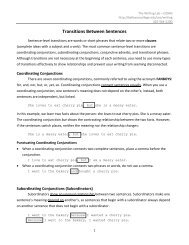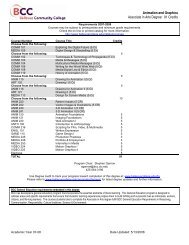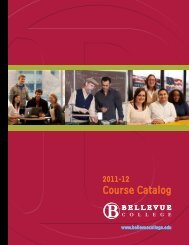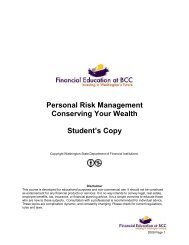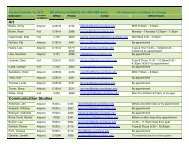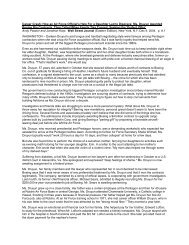Subjects and Verbs - Bellevue College
Subjects and Verbs - Bellevue College
Subjects and Verbs - Bellevue College
You also want an ePaper? Increase the reach of your titles
YUMPU automatically turns print PDFs into web optimized ePapers that Google loves.
<strong>Subjects</strong> <strong>and</strong> Verb Tenses<br />
The Writing Lab – D204d<br />
http://bellevuecollege.edu/asc/writing<br />
425-564-2200<br />
<strong>Subjects</strong> <strong>and</strong> <strong>Verbs</strong><br />
1. Every complete sentence must contain a subject <strong>and</strong> a verb. The subject is always the person,<br />
place, or thing doing an action. The simplest form of a verb is always an action.<br />
The dog barked at the mailman.<br />
In this sentence, the dog is the thing doing an action: barking. Therefore, the dog is the subject,<br />
<strong>and</strong> barked is the verb.<br />
2. Sometimes it can be difficult to locate a subject:<br />
On a hill under an old, gnarled tree howled a wolf.<br />
If you aren't sure what the subject is, try to find the verb. In this case, the verb (action) is<br />
howled. Now, ask yourself, "What howled?" The answer: a wolf howled. Therefore, in this<br />
sentence, wolf is the subject, <strong>and</strong> howled is the verb.<br />
3. Could, should, <strong>and</strong> would are another kind of verb called modals or delayed action verbs. They<br />
pass the action onto another word:<br />
You should see me now.<br />
I could take a nap.<br />
In this case, both parts (should see, could take) are considered verbs.<br />
4. Other kinds of verbs are used to link a subject to an adjective, such as am, are, was, were or<br />
seem.<br />
I am ready to eat.<br />
You seem angry with me.<br />
Both ready <strong>and</strong> angry are adjectives, used to describe the subjects I <strong>and</strong> you. The verbs am <strong>and</strong><br />
seem link the subjects with their adjectives.<br />
5. If the word to comes before the simple tense of a verb, it is not a verb. Instead it is called an<br />
infinitive.
6. The following auxiliary verbs are always verbs (unless the word before them is to):<br />
Am Are Be Been Is Was Were<br />
Can<br />
Could<br />
Do Does Did Done<br />
Has Have Had<br />
May Might<br />
Shall Should<br />
Will<br />
Would<br />
I am happy to be here.<br />
Here, the main verb is am <strong>and</strong> be is not a verb because it comes after the word to.<br />
7. One confusing verb form is the passive voice. The purpose of the passive voice is to shift<br />
attention away from the subject to the action:<br />
Mistakes were made by the government.<br />
The bank was robbed by the criminals.<br />
Both the linking verbs (was, were) <strong>and</strong> the main action verbs (made, robbed) are part of the<br />
phrasal verb – a verb that has more than one word.<br />
8. Often, like the passive voice, verbs contain more than one word. The present perfect tense,<br />
which shows an action in the past with ambiguity, contains the word have/has followed by the<br />
past participle. Here are some examples of past participles:<br />
Simple form Simple past Past participle<br />
swim swam swum<br />
think thought thought<br />
ride rode ridden<br />
I have swum in the ocean before.<br />
He has ridden a motorcycle for years.<br />
9. The past perfect tense is formed by combining the simple past of have (had) with the past<br />
participle. The past perfect is used to denote a past action in relation to another action at a<br />
different time in the past.<br />
The team had won by five o'clock.<br />
The train had stopped by the time I woke up.
10. The future tense discusses future events <strong>and</strong> is created by adding the simple form of a verb to<br />
will:<br />
I will call you tomorrow.<br />
The bill will come Thursday.<br />
11. The present progressive tense is used to show how something is right now. It is formed by<br />
adding the present tense of the to be verb (am, is, are) to the present participle. Here are some<br />
examples of present participles:<br />
Simple form<br />
call<br />
think<br />
eat<br />
Present participle<br />
calling<br />
thinking<br />
eating<br />
I am calling you.<br />
You are thinking about it.<br />
12. Three other progressive tenses include the past progressive, the future progressive, <strong>and</strong> the<br />
past perfect progressive. Form the past progressive by using was/were + the present participle.<br />
Form the future progressive by using will be + the present participle. Form the past perfect<br />
progressive by using had been + the present participle.<br />
Past progressive: I was sleeping when you called me.<br />
Future progressive: They will be driving when you call.<br />
Past perfect progressive: I had been walking for ten minutes when I got tired.<br />
13. The present participle (-ing form) is only part of a verb when an auxiliary verb comes in front of<br />
it. (See #6 for a list of auxiliary verbs).<br />
Maria has been running today.<br />
Maria prefers running over swimming.<br />
In the first sentence, running is part of the verb because two auxiliary verbs (has been) come<br />
before it. However, in the second sentence, running <strong>and</strong> swimming are gerunds. They are the<br />
things Maria prefers.



